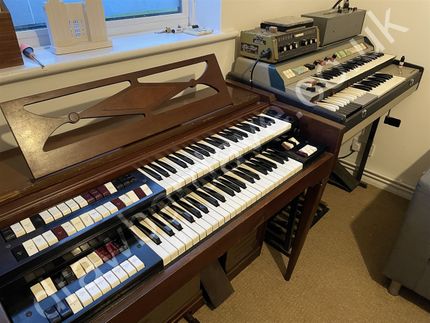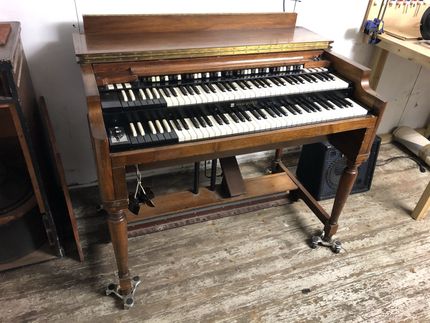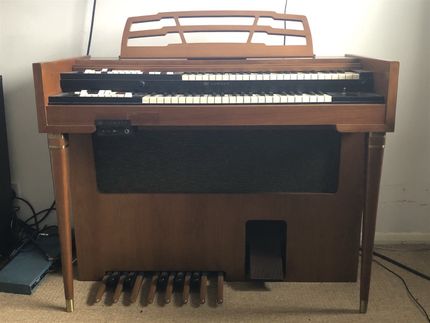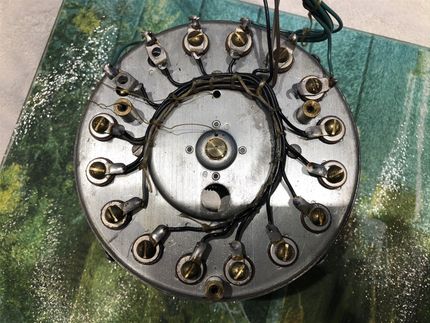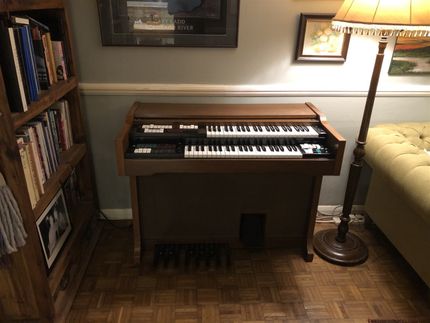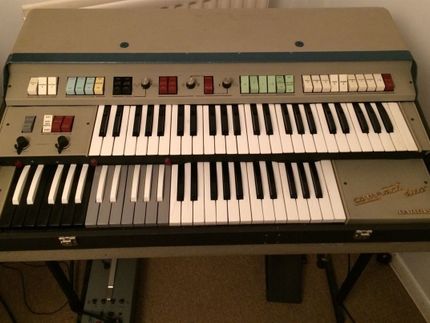Drawbar Dave
Vintage Valve Tonewheel Hammond Organ and Leslie Speaker Specialist. Valve Lowrey Organs, Vintage Keyboards Serviced and Repaired. Custom One Off Builds. Tour Preparation.
My Lowrey Heritage Deluxe DSO-1 Restoration
After many years of coveting the mighty Heritage Deluxe DSO-1 made famous by the likes of Alan Haven, Harry Stoneham and Rory More, I was offered one in need of considerable work.
It had spent much of its life in a Manchester working men's club before being rescued 10 years ago. At this point only the lower manual worked. It then spent 10 years in dry storage before I picked it up in January. As you can see in the first of the pictures, it had some cosmetic issues to say the least. Electronically it was very quiet and none of the features worked.
The first hurdle was to rebuild the power supply and due to the lack of space on the chassis, I opted to "re-stuff" the can capacitors with modern Panasonic discreet capacitors. This also preserved the look of the generator tray which to me is important on an instrument of this importance. The power supply had previously been re-capped with some maroon capacitors which can be seen in the early generator pictures. These were all removed to preserve the appearance. At this point I also found a few disconnected wires which I put back in their rightful place.
I now had most of the non-sustaining voices ie 16' and Quint working on the upper manual and all of the 8' and 4' on the lower manual. The keying of the sustaining voices (8'/4'/2') is achieved with firing neons aka the NE23. These reside on the generator tray next to each oscillator/divider circuit of which there are 12. Sometimes these neons snap off as their legs become brittle and in this case I could hear the tinkle of neons hitting the floor every time I opened the back of the organ. I decided to grasp the nettle and replace every single one. There are 19-20 for each of the 12 notes if you include the pedal keyer! I had been fortunate to grab over a thousand of the modern replacement neons when I had the chance.
Now I had all of my upper and lower tones working but still no pedals. There is a lot written on the web about "Lowrey pedal burble" I don't subscribe to the theory of moisture and humidity causing pedal issues. What I know for a fact is that the various busbars on the pedal switch assembly must have specific dc voltages for keying and cancellation (muting). Every time I tackle a pedal problem on a valve Lowrey I replace all of the voltage divider resistors, clean the contacts and busbars and reflow EVERY solder joint - remember these have taken a pounding over the years! The result is a solid, burble free pedal manual.
Ok. So now the pedals and manuals are all playing nicely so what next? Couplers and AOC. These were not working properly and the culprit was our old friend the NE23 neon again. There are two more sets of neons behind the lower manual that handle upper to lower coupling (so that you can play upper manual sustaining voices on the lower manual) and AOC or "Auto Orch". Again these were dropping off their boards so I opted to replace all of them with modern substitutes. I also did a couple of rounds of contact and busbar cleaning in the switching and keying circuits.
Everything on the organ was now generally working and I began the playing-in process over a month. This meant three to four hours of use every day. Every weekend I would have a list of niggles that had arisen such as intermittent contacts, dying divider packs etc that were failing from the sudden regular use of the organ. After four weeks it was fault free and I have enjoyed playing it every day since.
I must add as a footnote, my gratitude to those friends that know me as the "Lowrey guy" and have generously donated lots of spare Heritage parts to me which have made the cosmetic repairs possible - new logo strip, switch panel surrounds, foot pedal caps etc.
Richard's 1972 Hammond B3
Richard uses this organ to play and record with Van Morrison. The time had come to bite the bullet and get the foam removed from the manuals before it damaged any of the delicate resistance wiring. The organ also needed a scanner rebuild at the same time. The manuals were removed, dismantled, defoamed and cleaned. At the same time I added modifications for variable chorus and percussion level. The scanner had been over oiled in the past and I took it apart and bathed the componenents in acetone before wiping off with alcohol. Once the manuals and scanner were reinstalled I set about recapping the preamp and added a brilliance control. Other work included adding an output for a tone cabinet, upgrading the mains wiring and rewiring the outlet box which had some poor solder joints.
Lowrey Heritage DSA
I acquired this organ at the start of 2020 from a friend. I have always coveted the Lowrey Heritage Deluxe DSO made famous by the likes of Alan Haven and this DSA was a predecessor. Although it has all of the same tone and solo tabs of the DSO, it lacks AOC (Automatic Orchestra Control) and an internal Leslie. The Leslie is not a problem as I use a 145 or 147 with it as most professional organists did.
The organ was in very good cosmetic condition but as it had not been played for 30+ years it was not a wise idea to turn just it on and try it out.
Internally things were not as good. An electrolytic capacitor had failed and taken one of the Candohm/Muter high wattage resistors with it as I found after replacing all of the electrolytic capacitors and switching on. The high wattage resistor glowed orange whilst emitting smoke. A modern replacement resistor was sourced and for the first time the organ could be played and tested.
Many of the tones did not play ie certain footages on certain keys were missing. In 95% of cases this was down to broken neons. These are used on the sustaining note keying and light up and conduct when they receive a voltage that exceeds a specific threshold. With age, the legs break off and render the associated tone silent. I ended up replacing nearly a hundred of them across the tone generator panel. This included pedal notes that were missing.
A lot of the switches had intermittent faults. A blow through with compressed air whilst holding the vacuum cleaner hose close followed by liberal amounts of contact cleaner cleared up the issues.
Another major fault was the pedal burble which can be broken into two separate issues. First of all the notes did not cancel each other. As they are supposed to be monophonic this meant that if a note did not cancel it would make the subsequent note played gurgle. A good clean of the pedal generator circuits with Isopropyl Alcohol and a brush followed by rerouting of some of the wiring solved this problem. The second issue was that when pedal sustain was used, the decay of the note would sound like an explosion. This was found to be down to the sustaining neons in the pedal assembly firing at random. Despite the reason for this being widely blamed on dampness and humidity, I discovered that in fact the busbar voltages were too high due to failures in the voltage divider network. I replaced the guilty resistors with higher wattage versions because this appears to be a design fault. I know of two other models with exactly the same symptoms and cure.
With all of the above completed, all that remained was to install a Leslie connection for my 147 or 145 and the work was complete.
Greg's Scanner Vibrato service
Greg Boraman, owner of "The London Jazz Organ", a C3 that has been played by all of the great and good jazz organists including Jimmy Smith himself, asked me to carry out a service visit to rebuild the problematic vibrato scanner among other things.
Lowrey Berkshire Deluxe TBO-1
This organ is always referred to as the "Pete Townshend" organ because it was used on "Baba O'Reilly! and "Won't Get Fooled Again" as well as many other Who tracks. This is misleading as this organ is so much more than a celebrity endorsement organ.
It can be said that the TBO-1 was the natural successor to the DSO-1. It is solid state compared to the valve DSO-1 but compared side by side, the tabs of the same name actually do sound the same. Unfortunately Lowrey dropped the 5 1/3' and 2 2/3' Quint tabs by now so you cannot get the same nasal tone of the Heritage range.
I acquired this organ from a recording studio in Pershore. It was mostly in working order although the usual dirty switch contact problem blighted a few switches. It has a built in Leslie connection for a 145 rather like the DSO-1 and sounds fantastic through my 145 or 147. This is one of those reliable classic organs that I could never get rid of. Every time I play it I find new tonal palettes and inspiration. Run it direct from the headphone socket through a DI into effects units like Mr Townshend did and you can find a whole new world of sounds and textures. I like using an ensemble effect with delay and you can stray into polysynth territory!
My 1968 MKII Farfisa Compact Duo Combo Organ
This was my second Farfisa Compact Duo, replacing my 1966 MKI model. This one was filthy, the case was broken, some switches were broken, it did not make any sound. Once I managed to restore sound, it was out of tune. All in all I replaced about 130 electrolytic capacitors and about 4 germanium transistors.
That was 4 years ago and she still plays loud and strong and in tune! Some of the plastic switch actuators had broken. These organs are too rare and valuable to break for spares, so a work around was needed. I was able to fabricate metal hooks from heavy duty paperclips and bond them in place with super glue gel. So far they have lasted four years!
I am fortunate enough to own a Binson Echorec 2 Model T7E which is now paired with the Farfisa to nail those early Pink Floyd tones.
MKII Farfisa Compact Duo Pictures
2012 Bill Beer Chop Replica
I built this chop myself based on the design of the late great Bill Beer who built portablised B3s for music royalty. Stood on folding hairpin legs with a solid state custom preamp, this organ featured spring reverb, aux in, line out, bass, treble, percussion levels, master volume, 2x effects loop for upper and lower manuals and outputs for 3 different Leslie types. One remarkable feature was that the manuals could be pivoted up like the bonnet of a car and the top and back panels removed for all round access to the tone generator. This particular model was a copy of Pink Floyd's Bill Beer organ played by the wonderful late Rick Wright.

